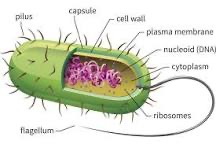Cell Organelles-Class notes
The Characteristics of Life
made up of one or more cells
displays organisation and structure
grows and develops
reproduces
responds to stimuli
requires energy
maintains homeostasis
adaptations evolve over time
Structure of Cells
Two types of Cells
Prokaryotes
bacteria
unicellular
oldest living thing
do not contain nuclei
small simple cells

Eukaryotes
plants, animals, fungi, and protists
unicellular or multicellular
contain nuclei
larger
many organelles with own membrane
highly specialised for their function
Organelles
All types of organelles
cell wall
cell membrane
cytoplasm
ribosomes
DNA
nucleus
rough endoplomic reticulum
gogli apparatus
vacoule
lysosome
Mitochondria
chloroplast
cell wall
outermost layer in plants, fungi, and prokaryotes
supports and protects the cell
cell membrane
controls materials entering and leaving the cell
supports and helps contain the cell and its form
cytoplasm
gel like substance that fills the cell
cyto=cell
site of many chemical reactions
ribosome
where proteins are assembled
proteins are assembled and necessary for all chemical reactions in the cell(enzymes)
DNA
includes instructions for most of the cells work, and gives everyone the job they have to do for the cell
Nucleus
contains most of the cells DNA
Rough Endoplasmic Reticulum(ER)
has ribosomes on its surface so it is involved in protein sythesis and transport of those proteins
Gogli Apparatus
warehouse of the cell
modifies, sorts, and packages proteins and materials to be ‘shipped out’(secreted)
the packages it secrets are called vesicles
Vacuole
stores materials such as salt, water and proteins
large central vacouls are located in plant cells
Lysosome
lys=break down
small vesicles with digestive proteins
work as a ‘clean up crew’
break down junk
white blood cells(wbc) have many
Mitochondria
power house of the cell
converts food into energy
have their own DNA
Chloroplast
Captures the suns energy and coverts it into chemical energy through photosynthesis
has chlorophyll to process the suns energy
acts like a solar power plant
not in the roots as these do not get sunlight
Difference of Plant and Animal cells
Plant
cell walls
chloroplasts - contain chlorophyll
larger
rarely have lysosomes
Animal
no cell wall
no chloroplast
some have small vacuoles
smaller
have lysosomes
Characteristics of Life
Living organisms are characterized by being made up of one or more cells, displaying organization and structure, growing and developing, reproducing, responding to stimuli, requiring energy, maintaining homeostasis, and evolving adaptations over time.
Structure of Cells
Cells can be divided into two main types: prokaryotes and eukaryotes. Prokaryotes are unicellular organisms, such as bacteria, that are considered the oldest living things. They do not contain nuclei and are small, simple cells. In contrast, eukaryotes include organisms such as plants, animals, fungi, and protists. They can be either unicellular or multicellular and contain nuclei, making them larger and more complex with many specialized organelles, each enclosed in its own membrane.
Organelles
Various organelles play critical roles in cell function. The cell wall, found in plants, fungi, and prokaryotes, serves as the outermost layer, supporting and protecting the cell. The cell membrane controls the materials entering and leaving the cell while maintaining its shape. The cytoplasm, a gel-like substance filling the cell, is where many chemical reactions occur. Ribosomes are sites where proteins are assembled, which are vital for all chemical reactions within the cell, including enzyme production. The DNA contains the instructions essential for cellular activities and dictates the roles of different cell components. The nucleus houses most of the cell's DNA.
The rough endoplasmic reticulum (ER), dotted with ribosomes, is involved in protein synthesis and the transport of proteins. The Golgi apparatus acts as the cell's warehouse, modifying, sorting, and packaging proteins and materials for secretion, referred to as vesicles. Vacuoles store materials such as salt, water, and proteins, with large central vacuoles commonly found in plant cells. Lysosomes function as the cell's cleanup crew, comprising small vesicles filled with digestive proteins that break down waste. Mitochondria, often described as the powerhouse of the cell, convert food into energy and contain their own DNA. Chloroplasts, present in plants but absent in roots, capture sunlight and convert it into chemical energy through photosynthesis.
Differences Between Plant and Animal Cells
Plant cells are distinguished by the presence of cell walls and chloroplasts, which contain chlorophyll. They are generally larger than animal cells and rarely have lysosomes. Conversely, animal cells lack cell walls and chloroplasts, may have small vacuoles, are smaller in size, and possess lysosomes.